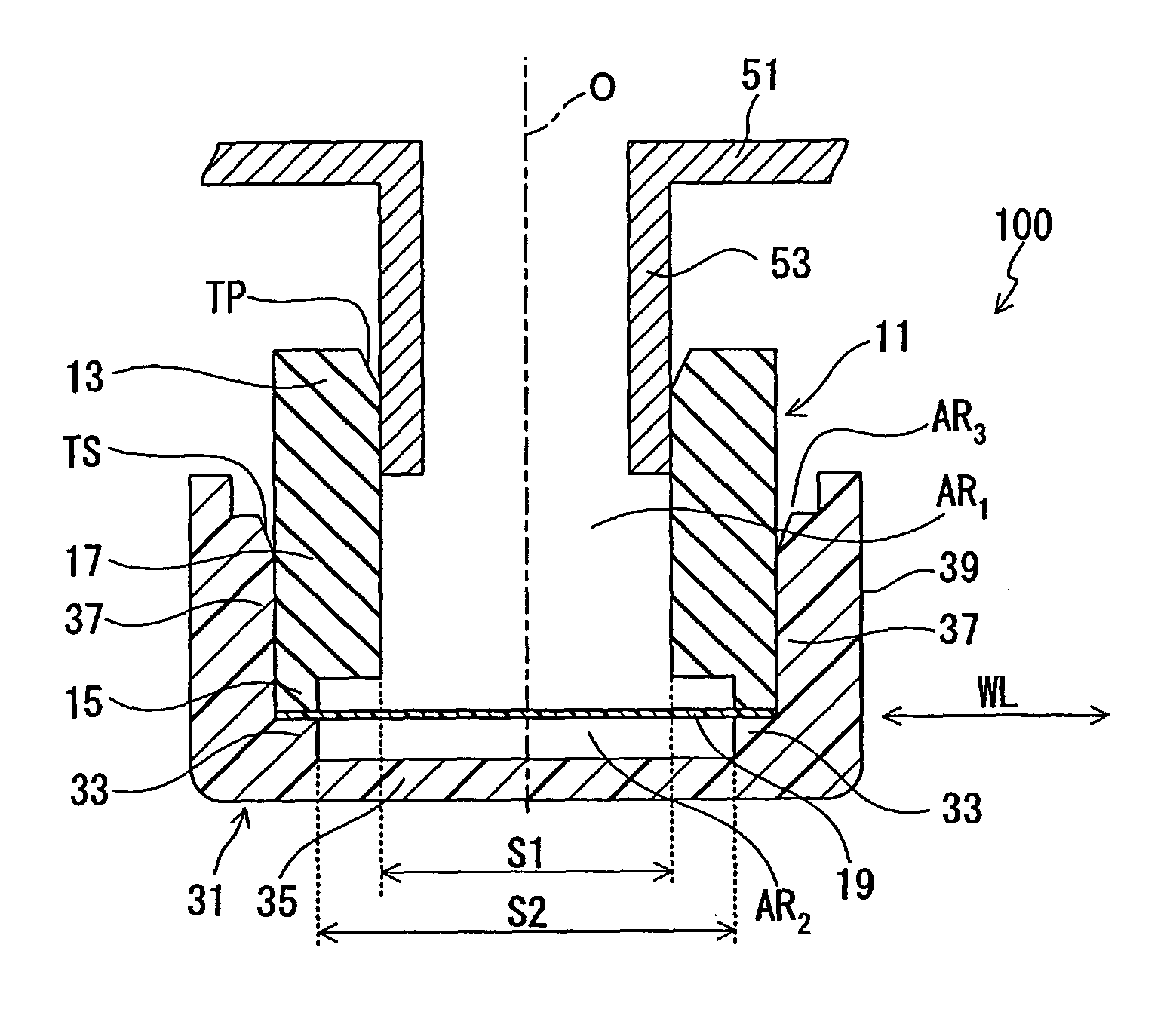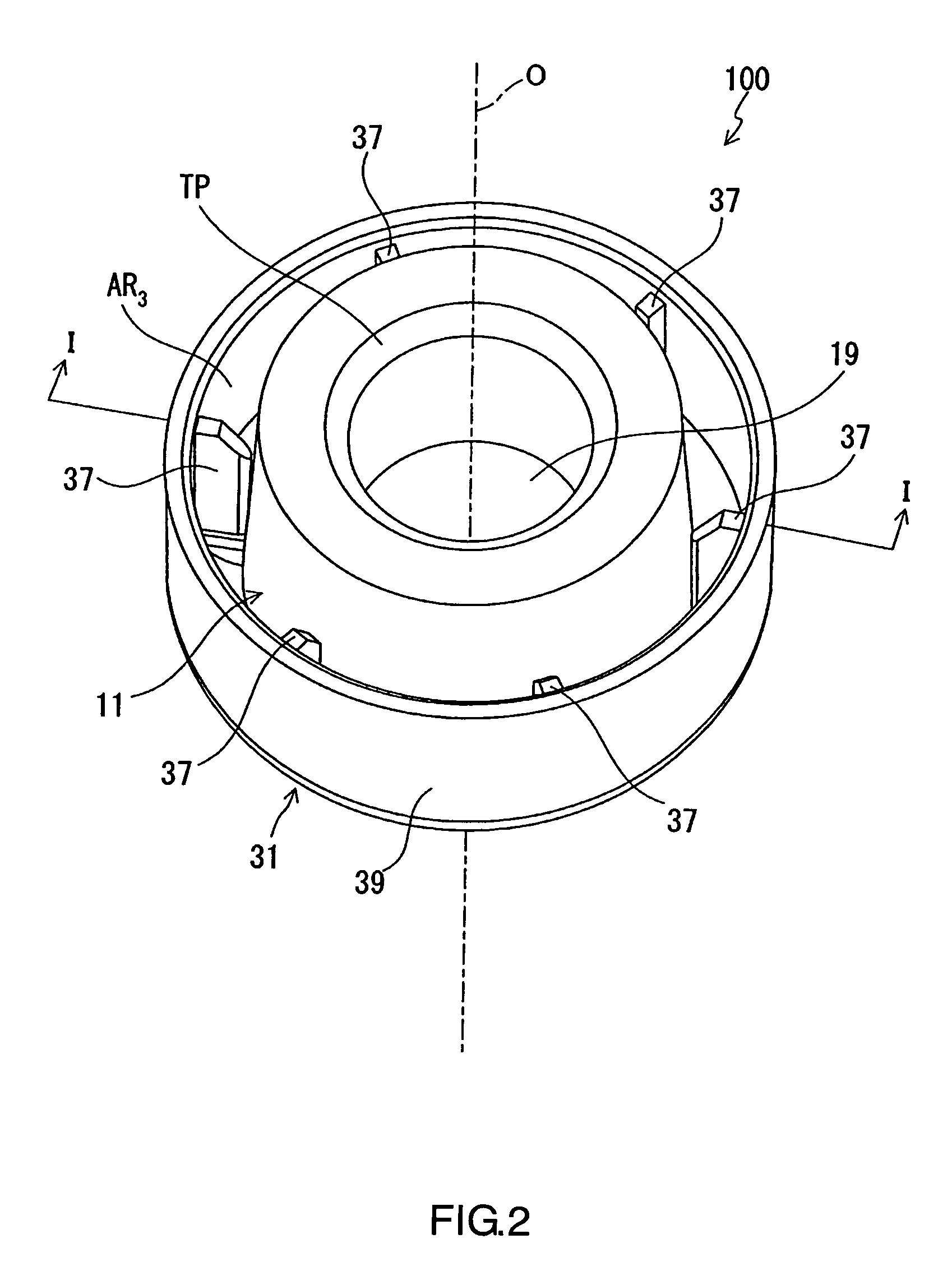Ventilation member
a technology of ventilation members and vents, which is applied in the direction of electrical apparatus casings/cabinets/drawers, lighting and heating apparatus, separation processes, etc., can solve the problems of inability to easily achieve the increase of gas permeation quantity of ventilation members, inability to achieve further improvement, and inability to easily adopt the size change of ventilation members, etc., to achieve shorten the molding time of tubular parts, improve productivity, and save costs
- Summary
- Abstract
- Description
- Claims
- Application Information
AI Technical Summary
Benefits of technology
Problems solved by technology
Method used
Image
Examples
first embodiment
[0040]FIG. 1 is a sectional perspective view of a ventilation member of the invention. FIG. 2 is a perspective view of the ventilation member of FIG. 1. FIG. 3 is a cross section showing a state where the ventilation member of FIG. 1 and FIG. 2 is attached to the housing of a device that needs ventilation. As is shown in FIG. 3, by attaching a ventilation member 100 to a nozzle-like filter-attached portion 53 provided to a housing 51 of the device, it is possible to ventilate the interior of the housing 51 while preventing the entry of foreign matter, such as water droplets. In addition, it is possible to maintain the internal pressure of the housing 51 equal to the external pressure.
[0041]As shown in FIG. 1, FIG. 2, and FIG. 3, the ventilation member 100 includes a tubular part 11, a gas permeable filter 19, and a cover part 31. The gas permeable filter 19, however, is omitted in FIG. 1. The tubular part 11 is of an almost circular cylindrical shape and forms a gas passage AR1 that...
second embodiment
[0060]FIG. 9 is a sectional perspective view of a second embodiment of the ventilation member of the invention. FIG. 10 is a perspective view of the ventilation member of FIG. 9. The gas permeable filter 19, however, is omitted in FIG. 9. Applicable objects and the function of a ventilation member 200 of the second embodiment are the same as those of the ventilation member 100 described in the first embodiment above. The configuration is also common in that a gas permeation quantity per unit time is increased owing to the effective area of the gas permeable filter 19 that is enlarged by making the opening area of a filter-end opening 65 larger than the opening area of a connection-end opening 63. A major difference from the embodiment described above is that fixing pieces 97, which play a crucial role in determining the relative positions of a tubular part 61 and a cover part 81, are formed integrally with the tubular part 61.
[0061]As shown in FIG. 9 and FIG. 10, the ventilation mem...
third embodiment
[0067]FIG. 15 is an exploded perspective view of a third embodiment of the ventilation member of the invention. FIG. 16 is a longitudinal cross section of the ventilation member of FIG. 15.
[0068]As shown in FIG. 15 and FIG. 16, a ventilation member 300 includes a tubular part 102, a gas permeable filter 19, and a cover part 110. The tubular part 102 is of an almost circular cylindrical shape, and a first gas passage BR1 and second gas passages BR2 isolated from the first gas passage BR1 are formed in the interior thereof. The first gas passage BR1 is a gas passage that directly communicates with the interior space of the housing of a device. The second gas passages BR2 are gas passages that directly communicate with the exterior space of the housing of the device and the ventilation member 300. The cover part 110 is a part inside of which the tubular part 102 is fit. It is formed of a bottom portion 112 forming a gap TH between itself and the gas permeable filter 19, a side wall por...
PUM
| Property | Measurement | Unit |
|---|---|---|
| pore diameter | aaaaa | aaaaa |
| pore diameter | aaaaa | aaaaa |
| thickness | aaaaa | aaaaa |
Abstract
Description
Claims
Application Information
 Login to View More
Login to View More - R&D
- Intellectual Property
- Life Sciences
- Materials
- Tech Scout
- Unparalleled Data Quality
- Higher Quality Content
- 60% Fewer Hallucinations
Browse by: Latest US Patents, China's latest patents, Technical Efficacy Thesaurus, Application Domain, Technology Topic, Popular Technical Reports.
© 2025 PatSnap. All rights reserved.Legal|Privacy policy|Modern Slavery Act Transparency Statement|Sitemap|About US| Contact US: help@patsnap.com



